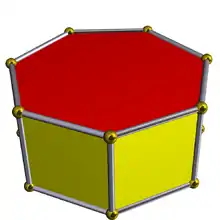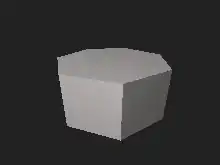Heptagonal prism
In geometry, the heptagonal prism is a prism with heptagonal base. This polyhedron has 9 faces, 21 edges, and 14 vertices.[1][2]
| Heptagonal prism | |
|---|---|
 | |
| Type | Uniform polyhedron |
| Faces | 2 Heptagons 7 squares |
| Edges | 21 |
| Vertices | 14 |
| Vertex configuration | 7.4.4 |
| Wythoff symbol | 2 7 | 2 |
| Coxeter diagram | |
| Symmetry group | D7h, [7,2], (*722), order 28 |
| Rotation group | D7, [7,2]+, (722), order 14 |
| Dual polyhedron | Heptagonal bipyramid |
| Properties | Convex semiregular |
| Vertex figure | |
 | |

3D model of a (uniform) heptagonal prism.
Area
The area of a right heptagonal prism with height and with a side length of and apothem is given by:[1]
Volume
The volume is found by taking the area of the base, with a side length of and apothem , and multiplying it by the height , giving the formula:[1]
This formula also works for the oblique prism due to the Cavalieri's principle.
Images
The heptagonal prism can also be seen as a tiling on a sphere:
Related polyhedra
| Family of uniform prisms | |||||||||||
|---|---|---|---|---|---|---|---|---|---|---|---|
| Polyhedron | |||||||||||
| Coxeter | |||||||||||
| Tiling | |||||||||||
| Config. | 2.4.4 | 3.4.4 | 4.4.4 | 5.4.4 | 6.4.4 | 7.4.4 | 8.4.4 | 9.4.4 | 10.4.4 | 11.4.4 | 12.4.4 |
References
- Sapiña, R. "Area and volume calculator of a heptagonal prism" (in Spanish). Problemas y ecuaciones. ISSN 2659-9899. Retrieved June 17, 2020.
- Pugh, Anthony (1976), Polyheda: A Visual Approach, University of California Press, p. 27, ISBN 9780520030565.
This article is issued from Wikipedia. The text is licensed under Creative Commons - Attribution - Sharealike. Additional terms may apply for the media files.
